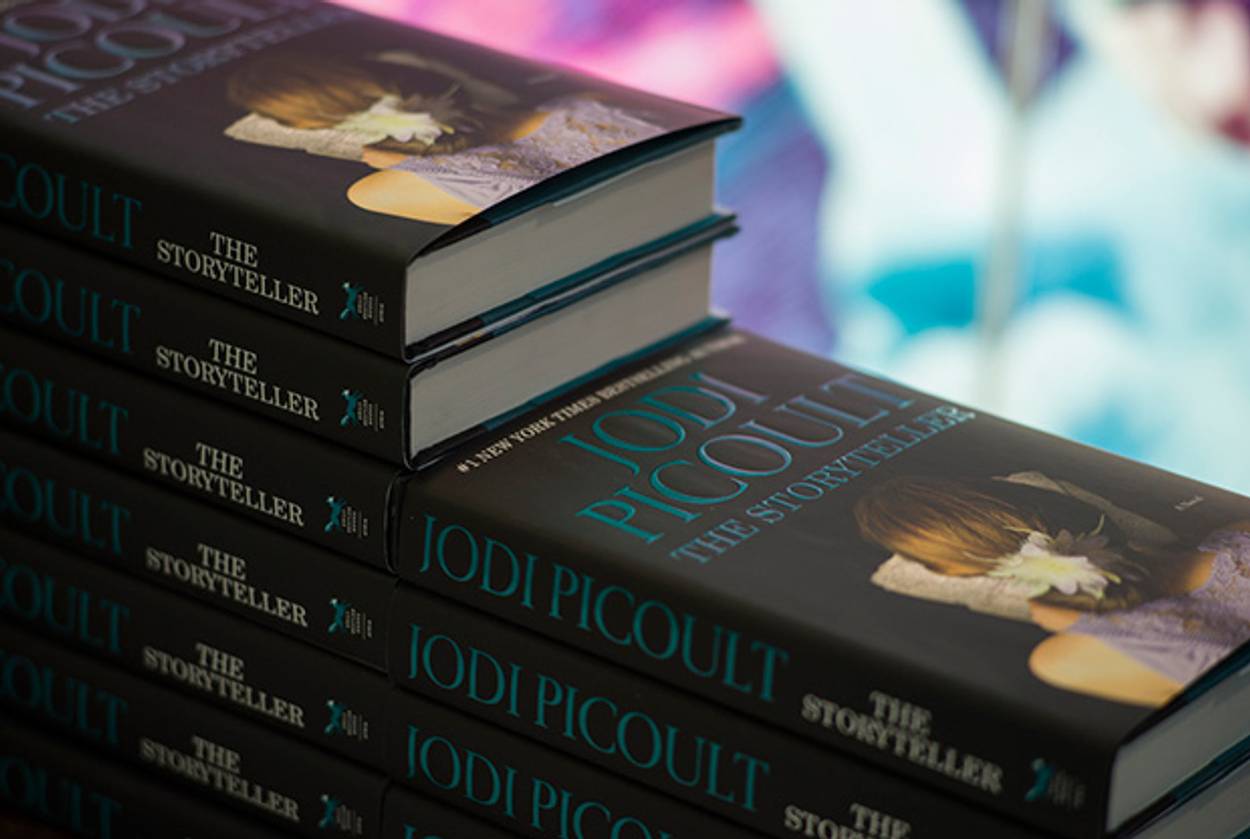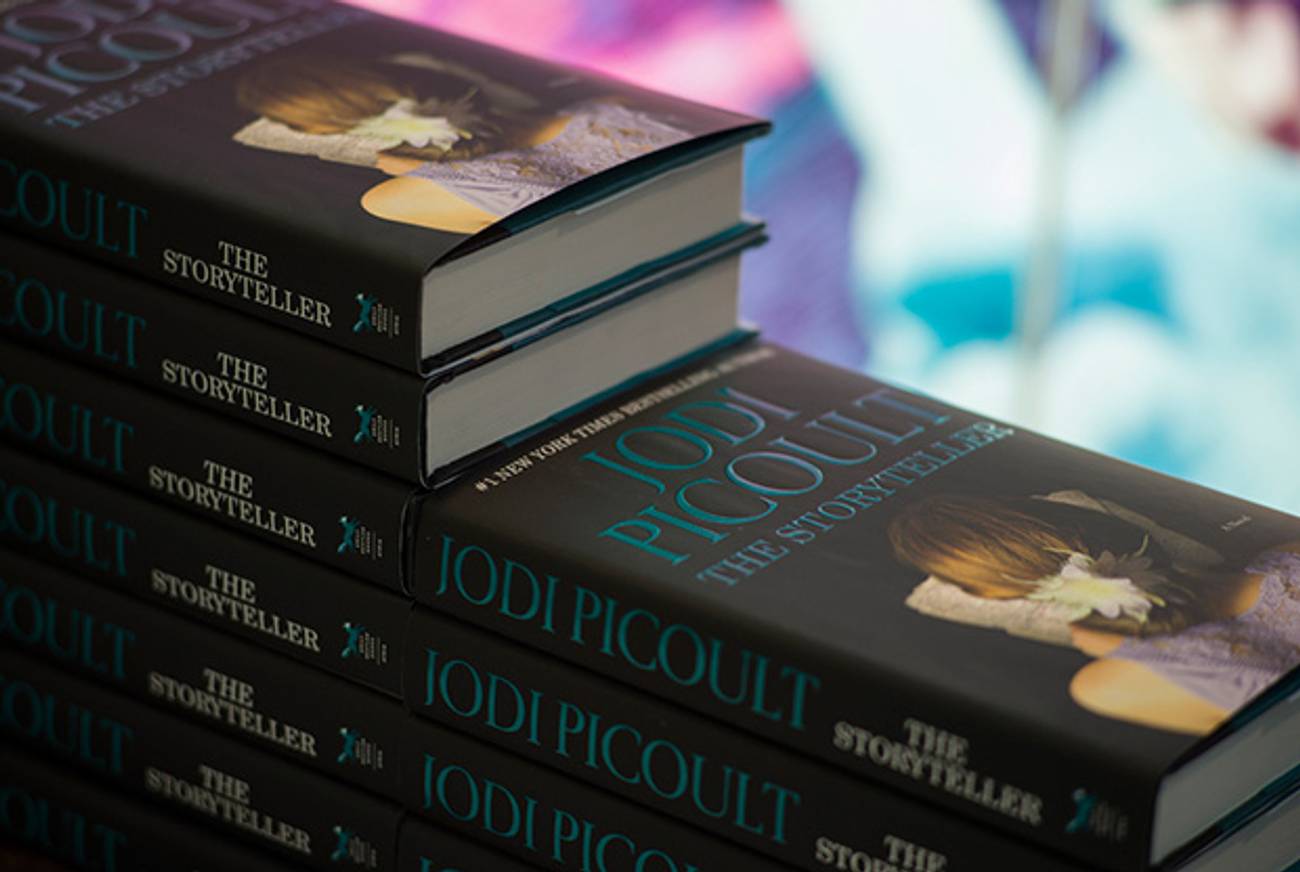Jodi Picoult’s Holocaust Vampires
Some historians see the best-selling writer’s new novel The Storyteller as trash. Here’s why they are wrong.




Jodi Picoult’s wildly successful novels, which have sold over 14 million copies, tend to rely on a simple formula: a controversial, sexy topic expressed in a courtroom drama with a twist at the end. Her latest, The Storyteller, which was released last month, weaves together the narratives of three characters: 25-year-old Sage Singer, a recluse and a baker; her grandmother, a Holocaust survivor; and Josef Weber, a 90-year-old ex-Nazi asking for Sage’s forgiveness as a Jew and for her assistance in his suicide.
The conventions of Holocaust fiction—brutality, sexual abuse, forced labor—tellingly overlap with other sensationalist conventions (the young-adult genre, the Jodi Picoult novel). “It’s great material for art,” says Joseph Skibell, a novelist whose book A Blessing on the Moon is Holocaust fiction. “It’s writ large, with big questions like good vs. evil.” Without subjects like war, “all you have is the mundane. It’s why so much American fiction is about white men committing adultery,” Skibell adds wryly.
While Skibell remembers a time when there was what he calls a “prohibition against Holocaust fiction” and his own book was barred from the Holocaust Museum’s bookstore, Holocaust fiction is now a staple in bookstores with its own category on Amazon. But it’s still worth asking—since others undoubtedly will—whether the Holocaust should be treated as fodder for a best-selling thriller like Picoult’s. “I tend to be persuaded by the argument that makes sense of fictionalizing,” David Mikics, a professor of English at the University of Houston, told me on the phone. “Everything is legitimate if it helps you understand,” he said, with the caveat that, “mythologizing can obscure reality in a problematic way.”
Ruth Franklin, who has written about the question of art and the Holocaust in her book A Thousand Darknesses: Lies and Truth in Holocaust Fiction, also disagrees with those who wish to remove the Holocaust from the grasp of art. “I don’t think it’s our job to tell people what to write about,” she told me on the phone. Furthermore, she believes “it’s not the artist’s obligation to be a historian. That’s the historian’s job.” To question whether a work of art exploits the Holocaust is, for Franklin, to question the artist’s intent—which is not as interesting or important as questioning the work of art, which must be evaluated on its own terms. “Artists have to cover costs,” she says about Holocaust films that make money, like Roberto Benigni’s Life Is Beautiful, which Franklin says has a legitimate aesthetic claim to the title of art.
But there are those who think that there is something that distinguishes the Holocaust from other bloody historical events, like the American Civil War. Deborah Lipstadt, the author of the books Denying the Holocaust and Nextbook Press’s The Eichmann Trial, felt that Benigni’s film was a mistake. “I hated Life Is Beautiful,” she told me; “It just made light of the whole thing.” Lipstadt believes that when writing about genocide, slavery, and the Holocaust, “the writer has a certain obligation not to play too fast with the truth. Of course, fiction is fiction,” she conceded, “but when dealing with these topics, it is important to make sure the fiction does not distort history.”
Alvin Rosenfeld, director of the Institute for the Study of Contemporary Anti-Semitism and a professor of Jewish studies at Indiana University, has written a book called A Double Dying: Reflections on Holocaust Literature. He, too, believes that Holocaust literature falls into two categories: the insightful, which includes The Last of the Just, by Andre Schwarz-Bart and The Reader, by Bernhard Schlink and the works of 2002 Nobel laureate Imre Kertész; and the distorting, including William Styron’s Sophie’s Choice, with its portrayal of a Polish woman and Auschwitz survivor who is victimized by her “rough and vulgar Jewish boyfriend,” and Life Is Beautiful, the fable at the heart of which bears no relationship to the camps. While he firmly believes that, “No one should legislate what any artist produces,” he thinks that the audiences must learn to read and view critically. “You should think, as well as feel,” he told me. “Since the Holocaust is a crime of such horrific dimensions, one doesn’t want to see it commercialized or trivialized. The past is not fixed, and one doesn’t want to lose the historical veracity.”
All these experts seem to agree that distortion or sensationalizing should be the barriers standing between an author and the Holocaust as setting. But another threat looms in the nature of storytelling itself: It lends closure. Adorno famously said that there is no poetry after Auschwitz, but this might very well apply as well to fiction, and in particular, Holocaust fiction. The bugbear that aspiring Holocaust novelists should fear is not sensationalism, but the inherently tempting but ahistorical comforts of resolution.
Picoult’s success comes from addressing these narrative concerns overtly, for The Storyteller is no less about the nature of fiction than it is about the Holocaust. One third of the novel gives readers the chance to inhabit the day, the life, the thoughts, of a Nazi officer in situ, who, like every Picoult character, is a damn good storyteller. Her skillful prose ennobles abjection even as it brings atrocity close to home. Not so close as to shock, mind you, but close enough to reveal a shift in what sorts of narratives can be told about the Holocaust. Another one of the characters tells a story about vampires, which is woven in with the three narratives—making the comparison of YA novels and Holocaust fiction explicit. The vampiric tale, with its guts and its gore, its love plot and its aggressive sensuality, which the character must keep telling as a means to survival, throws into stark relief the Holocaust tale, denuding the latter of its usual effects by appropriating them and outdoing them.
What’s most shocking about The Storyteller is its unexpected power as a meditation on the power of fiction as a means of facilitating an escape route from the banality of binaries: good vs. evil, victim vs. perpetrator, Nazi vs. Jew. Picoult wanted to understand, more than she wanted to judge, and in doing so, she refuses the easy closure offered by narrative and shows us how using the Holocaust as a subject for popular fiction—even vampire fiction—is not to be feared.
***
Like this article? Sign up for our Daily Digest to get Tablet Magazine’s new content in your inbox each morning.
Batya Ungar-Sargon is a freelance writer who lives in New York. Her Twitter feed is @bungarsargon.
Batya Ungar-Sargon is a freelance writer who lives in New York. Her Twitter feed is @bungarsargon.